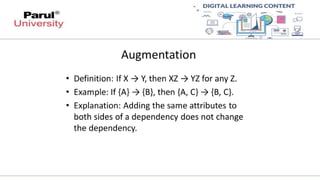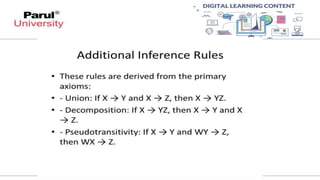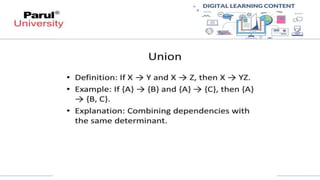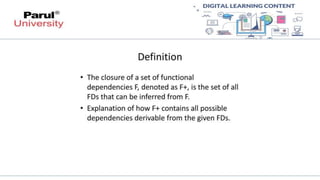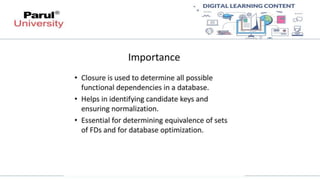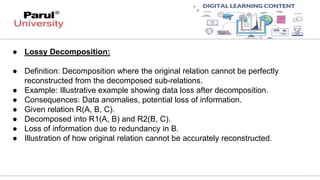Relational Database Design Functional Dependency – definition, trivial and non-trivial FD, Armstrong's Axioms/Inference Rules
- 1. Database Management System Bhoomika Patel , Assistant Professor Computer Science & Engineering
- 3. Content s ● Functional Dependency – definition, trivial and non-trivial FD ● Armstrong's Axioms/Inference Rules ● Closure of FD ● Closure of Attributes ● Candidate Key ● Finding a Candidate Key ● Decomposition (Lossy & Lossless) ● Database Anomalies ● normalization – 1Nf, 2NF, 3NF, BCNF, 4NF, 5NF
- 4. ● Functional Dependency: ● Brief overview of databases and the importance of data integrity. ● Introduction to Functional Dependencies (FD) as a concept ensuring data consistency. ● Functional Dependency (FD) is a constraint between two sets of attributes in a relation from a database. ● Notation: X→YX rightarrow YX→Y ● Meaning: Attribute Y is functionally dependent on attribute X if each value of X is associated with precisely one value of Y. ● Example: ● Table with attributes: StudentID, StudentName, CourseID, CourseName ● Example FD: StudentID→StudentNameStudentID rightarrow StudentNameStudentID→StudentName, CourseID→CourseNameCourseID rightarrow CourseNameCourseID→CourseName ● Explanation of the relationship between the attributes.
- 5. ● Trivial Functional Dependency: ● Definition: A functional dependency X→YX rightarrow YX→Y is trivial if YYY is a subset of XXX. ● Example: If X={A,B}X = {A, B}X={A,B}, then A→AA rightarrow AA→A and {A,B}→A{A, B} rightarrow A{A,B}→A are trivial FDs. ● Explanation: These dependencies hold true by default.
- 6. ● Non-Trivial Functional Dependency: ● Definition: A functional dependency X→YX rightarrow YX→Y is non-trivial if YYY is not a subset of XXX. ● Example: If X={A}X = {A}X={A} and Y={B}Y = {B}Y={B}, then A→BA rightarrow BA→B is non- trivial. ● Explanation: These dependencies provide meaningful constraints in database design.
- 24. ● Candidatekey: ● A candidate key is a minimal set of attributes that can uniquely identify a tuple in a relation. ● Every relation can have one or more candidate keys. ● Finding candidate key: Given a relation and a set of functional dependencies: ● Relation R(A, B, C, D) ● FDs: {A → B, C → D} Step-by-step process to identify candidate keys.
- 25. ● Decomposition: ● Decomposition is the process of breaking down a relation into two or more sub-relations. ● Purpose: To eliminate redundancy, prevent anomalies, and ensure data integrity. ● Types: ● Lossy Decomposition ● Lossless Decomposition
- 26. ● Lossy Decomposition: ● Definition: Decomposition where the original relation cannot be perfectly reconstructed from the decomposed sub-relations. ● Example: Illustrative example showing data loss after decomposition. ● Consequences: Data anomalies, potential loss of information. ● Given relation R(A, B, C). ● Decomposed into R1(A, B) and R2(B, C). ● Loss of information due to redundancy in B. ● Illustration of how original relation cannot be accurately reconstructed.
- 28. ● Lossless Decomposition: ● Definition: Decomposition where the original relation can be perfectly reconstructed from the decomposed sub-relations. ● Conditions: Dependency preservation and ensuring common attributes form a super key. ● Importance: Ensures data integrity and prevents anomalies. ● Given relation R(A, B, C). ● Decomposed into R1(A, B) and R2(A, C). ● Reconstruction: Natural join of R1 and R2 restores the original relation. ● Illustration of how the original relation is accurately reconstructed.
- 29. ● Database Anomalies: ● Definition: Inconsistencies or errors in a database due to improper database design. ● Causes: Typically caused by redundancy and lack of normalization.
- 30. First Normal Form (1NF) ○ Definition: A relation is in 1NF if it contains only atomic (indivisible) values. ○ Rules: No repeating groups, no multi-valued attributes. ○ Example: Converting a table with repeating groups to 1NF. Example: First Normal Form (1NF) ○ Initial table with repeating groups. ○ Conversion to 1NF by eliminating repeating groups and ensuring atomic values.
- 31. Second Normal Form (2NF) ○ Definition: A relation is in 2NF if it is in 1NF and all non-key attributes are fully dependent on the primary key. ○ Rule: Eliminate partial dependencies. ○ Example: Converting a table from 1NF to 2NF. example: Second Normal Form (2NF) ○ Initial table in 1NF with partial dependencies. ○ Conversion to 2NF by removing partial dependencies and creating separate tables.
- 32. Third Normal Form (3NF): ○ Definition: A relation is in 3NF if it is in 2NF and all the attributes are functionally dependent only on the primary key. ○ Rule: Eliminate transitive dependencies. ○ Example: Converting a table from 2NF to 3NF. Example: Third Normal Form (3NF) ○ Initial table in 2NF with transitive dependencies. ○ Conversion to 3NF by removing transitive dependencies and creating separate tables.
- 33. Boyce-Codd Normal Form (BCNF) ○ Definition: A relation is in BCNF if it is in 3NF and every determinant is a candidate key. ○ Rule: Handle situations where 3NF is insufficient. ○ Example: Converting a table from 3NF to BCNF. Example: Boyce-Codd Normal Form (BCNF) ○ Initial table in 3NF with anomalies. ○ Conversion to BCNF by ensuring every determinant is a candidate key.
- 34. Fourth Normal Form (4NF) ○ Definition: A relation is in 4NF if it is in BCNF and has no multi-valued dependencies. ○ Rule: Eliminate multi-valued dependencies. ○ Example: Converting a table from BCNF to 4NF. Example: Fourth Normal Form (4NF) ○ Initial table in BCNF with multi-valued dependencies. ○ Conversion to 4NF by removing multi-valued dependencies and creating separate tables.
- 35. Fifth Normal Form (5NF) ○ Definition: A relation is in 5NF if it is in 4NF and has no join dependencies. ○ Rule: Eliminate join dependencies. ○ Example: Converting a table from 4NF to 5NF. Example: Fifth Normal Form (5NF) ○ Initial table in 4NF with join dependencies. ○ Conversion to 5NF by removing join dependencies and ensuring that the table can be decomposed into smaller tables without loss of information.









